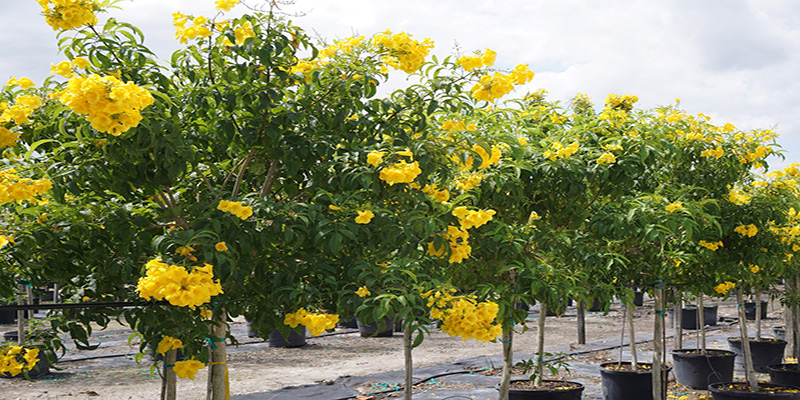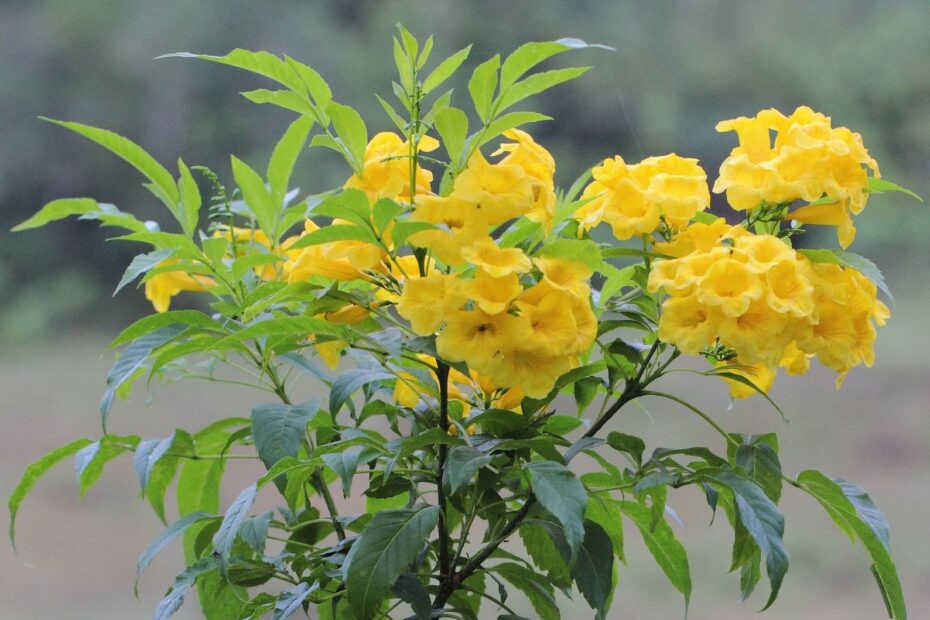Common Names: Yellow Bells, Yellow Elder, Esperanza, Ginger-Thomas
Family: Bignoniaceae
Parts Used: Leaves, flowers, stem bark
Energetics: Bitter, cooling, drying
Traditional Systems: Indigenous Mesoamerican, Caribbean, African-American folk medicine
Botanical Overview
Tronadora, scientifically known as Tecoma stans, is a vibrant flowering shrub or small tree characterized by its striking trumpet-shaped yellow blossoms. Native to the Americas, it spans from the southern United States through Mexico, Central America, and the Caribbean. This resilient plant thrives in arid, sunny environments, commonly found along roadsides or on dry hillsides. Beyond its ornamental appeal, Tronadora is valued for its therapeutic properties and is widely cultivated for both aesthetic and medicinal purposes.
Phytochemistry & Active Compounds
Tecoma stans contains a variety of biologically active constituents, including:
- Alkaloids: Tecomine and tecostanine, which are linked to its hypoglycemic effects.
- Flavonoids: Such as luteolin and apigenin, contributing antioxidant and anti-inflammatory properties.
- Tannins: Providing astringent and antimicrobial effects.
- Iridoids: Bitter glycosides that support liver function.
- Saponins and Phytosterols: Supporting immune and metabolic balance.
Medicinal Uses
1. Blood Sugar Regulation (Diabetes Support)
Tronadora is highly regarded in traditional medicine for managing type 2 diabetes and insulin resistance, particularly in Mexico and Central America, where it is prepared as a tea to lower blood sugar.
- Mechanism: Tecomine and other alkaloids may mimic insulin, enhancing glucose uptake.
- Research: Animal studies demonstrate significant hypoglycemic effects, sparking interest in its potential as a plant-based diabetes therapy.
- Clinical Insight: Some herbalists compare its action to bitter melon, suggesting it may act as a natural GLP-1 mimic, beneficial for early-stage type 2 diabetes and metabolic syndrome.
2. Respiratory Health
The flowers and leaves are used to alleviate coughs, bronchitis, and asthma symptoms through decoctions that act as expectorants and antispasmodics.
- Action: Loosens mucus, reduces bronchial inflammation, and calms spasms.
- Combinations: Often paired with mullein or elderflower in traditional remedies for enhanced respiratory support.
3. Liver & Gallbladder Support
The bitter compounds in Tronadora stimulate bile flow, making it a valuable cholagogue and hepatic tonic for liver stagnation, poor digestion, and detoxification.
- Applications: Supports conditions like jaundice, gallstones, and general liver sluggishness.
- Energetics: Its cooling and drying properties are ideal for overheated or damp liver conditions.
4. Antimicrobial & Anti-inflammatory
Tronadora is traditionally used to treat infections, skin eruptions, and wounds. A poultice or wash made from the leaves disinfects and promotes healing of cuts, boils, and abscesses.
- Internal Use: Effective against parasitic infections and intestinal worms.
- External Use: Applied as a wound rinse, compress, or infused oil for skin conditions.
5. Diuretic and Mild Laxative
In folk medicine, Tronadora serves as a diuretic to relieve water retention and support kidney and bladder health. Its mild laxative properties aid in colon cleansing and constipation relief, especially when combined with herbs like senna or cascara.
6. Anti-Anxiety and Nervous System Support (Emerging Use)
While less documented, some traditional healers in the Caribbean and Central America use Tronadora tea for its calming effects, particularly in cases of stress-related digestive upset or mild anxiety.
- Mechanism: The bitter and cooling energetics may soothe an overactive nervous system, while flavonoids like apigenin, known for anxiolytic properties in other plants (e.g., chamomile), could contribute to mild sedative effects.
- Extended Use: Herbalists speculate that Tronadora’s calming effect may support sleep quality or reduce nervous tension when used in low doses, often combined with herbs like lemon balm or passionflower. However, this use is anecdotal and requires further research.
7. Pain and Inflammation Relief (Traditional and Potential Use)
In some indigenous practices, Tronadora leaves are used in poultices or baths to relieve muscle aches, joint pain, or inflammatory conditions like arthritis.
- Mechanism: Flavonoids and tannins provide anti-inflammatory and analgesic effects, potentially reducing localised pain and swelling.
- Extended Use: In rural communities, Tronadora-infused baths are used for post-injury recovery or chronic pain management, particularly for rheumatic conditions. The plant’s anti-inflammatory properties may complement other pain-relieving herbs like turmeric or ginger in topical or internal preparations, though scientific evidence is limited.

Herbal Recipes
-
Tronadora Blood Sugar Tea
- Purpose: Supports blood sugar regulation and metabolic health.
-
Ingredients:
- 1–2 tsp dried Tronadora leaves
- 1 tsp dandelion root
- 1 tsp burdock root
- 1 cup boiling water
-
Instructions:
- Combine herbs in a teapot or heat-safe container.
- Pour boiling water over the herbs and steep for 10–15 minutes.
- Strain and drink 1–2 times daily, preferably before meals.
- Note: Monitor blood sugar levels if combining with diabetes medications.
-
Tronadora Respiratory Decoction
- Purpose: Relieves coughs, bronchitis, and asthma symptoms.
-
Ingredients:
- 1 tsp dried Tronadora leaves
- 1 tsp mullein leaves
- 1 tsp elderflower
- 2 cups water
-
Instructions:
- Add herbs to a saucepan with water and bring to a boil.
- Reduce heat and simmer for 15-20 minutes.
- Strain and sip slowly, 1-2 cups daily as needed for respiratory relief.
- Note: Add honey for soothing effect if desired, but avoid in diabetes.
-
Tronadora Wound Healing Poultice
- Purpose: Promotes healing of cuts, boils, or skin infections.
-
Ingredients:
- 1 handful fresh Tronadora leaves (or 2 tbsp dried, rehydrated)
- 1 tsp calendula flowers (optional for added anti-inflammatory effect)
- Clean cloth or gauze
-
Instructions:
- Crush fresh leaves (or rehydrate dried leaves with warm water) to release juices.
- Mix with calendula flowers if using.
- Apply directly to the affected area and cover with a clean cloth or gauze.
- Leave on for 1-2 hours, then rinse. Repeat 1-2 times daily until healed.
- Note: Ensure the wound is clean before application to prevent infection.
Preparation & Dosage
-
Infusion (Tea)
- Ingredients: 1-2 teaspoons of dried or fresh leaves per cup of hot water.
- Method: Steep for 10-15 minutes, consume 1-2 times daily.
- Combinations: Blend with dandelion, elderberry, or burdock for enhanced cleansing effects.
-
Tincture
- Preparation: Use fresh or dried leaves in a 1:2 or 1:5 vegetable glycerine or alcohol ratio.
- Dosage: 1–3 ml, up to 3 times daily.
- Combinations: Pair with gymnema, pau d’arco, or neem for blood sugar or infection support.
-
Poultice or Wash
- Method: Apply crushed fresh leaves or a strong infusion topically for wounds, eczema, or fungal conditions.
Cautions & Contraindications
- Pregnancy & Lactation: Avoid use due to its strong bitter properties and potential uterine stimulation.
- Hypoglycemia: May significantly lower blood sugar; monitor closely if taking diabetes medications.
- Overuse: Prolonged or excessive use may irritate the gastrointestinal tract or liver.
- Drug Interactions: Exercise caution when combining with pharmaceuticals for diabetes or diuretics.
Traditional & Spiritual Uses
In Afro-Caribbean and indigenous traditions, Tronadora is used in cleansing rituals to dispel negative energy or stagnation from the body and spirit. Its bright yellow flowers are associated with solar energy, symbolising clarity and vitality.
Scientific Backing
Modern pharmacological studies validate several traditional uses:
- Hypoglycaemic Effect: Confirmed in animal models, supporting its role in blood sugar regulation (Hammouda et al., 1974).
- Antibacterial: Effective against pathogens like E. coli, Staph. aureus, and P. aeruginosa (Binutu et al., 1996).
- Antioxidant & Anti-inflammatory: Flavonoids and tannins reduce oxidative stress and inflammation (Kameshwaran et al., 2012).
- Hepatoprotective: Demonstrates protection against induced liver toxicity in animal studies (Singh et al., 2015).
Formulation Ideas (Dr. Sebi-Inspired)
Tronadora is often incorporated for:
- Diabetes (Blood Sugar Blend): Combine with dandelion root, elderberry, and burdock root.
- Liver Cleanse Formula: Blend with sarsaparilla, yellow dock, and boldo.
- Respiratory Support: Mix with mullein, elderflower, and aniseed.
References
- Binutu, O. A., et al. (1996). “Antimicrobial activity of Tecoma stans leaf extracts.” Fitoterapia, 67(4), 307–310.
- Hammouda, Y., et al. (1974). “Hypoglycemic activity of Tecoma stans alkaloids in experimental animals.” Journal of Pharmaceutical Sciences, 63(8), 1252–1255.
- Kameshwaran, S., et al. (2012). “Antioxidant and anti-inflammatory activities of Tecoma stans.” Journal of Ethnopharmacology, 140(2), 234–240.
- Singh, B., et al. (2015). “Hepatoprotective effects of Tecoma stans against induced liver toxicity in rats.” Phytotherapy Research, 29(6), 897–904.
Summary
Tecoma stans, or Tronadora, is a potent and versatile herb with deep roots in traditional medicine. Its applications range from blood sugar regulation and liver support to respiratory health and antimicrobial action. Supported by both traditional knowledge and emerging scientific evidence, this vibrant plant offers significant therapeutic potential, particularly for metabolic health and detoxification. Its underutilization in modern Western herbalism makes it a compelling candidate for renewed exploration in holistic health practices.
This article is copyrighted by Ital is Vital, 2025. Want to re-post this article? Visit our guidelines.
DISCLAIMER: THIS WEBSITE DOES NOT PROVIDE MEDICAL ADVICE
The information, including but not limited to, text, graphics, images and other material contained on this website are for informational purposes only. The purpose of this website is to promote broad consumer understanding and knowledge of various health topics. It is not intended to be a substitute for professional medical advice, diagnosis or treatment. Always seek the advice of your physician or other qualified health care provider with any questions you may have regarding a medical condition or treatment and before undertaking a new health care regimen, and never disregard professional medical advice or delay in seeking it because of something you have read on this website.

I also use mullein for respiratory health, next time I’ll try to add tronadora into my herbal tea for lungs. I’m really interested in different natural remedies after reading this article about mullein and its healing properties https://nutra-harmony.com/blogs/news/mullein-extract-for-respiratory-health-reviews-studies-and-dosage-tips